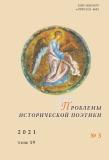Архетипические константы и трансформации русского романа
Archetypical Constants and Transformations of the Russian Novel
Author(s): Irina Belyaeva, Elzbieta Tyszkowska-KasprzakSubject(s): Novel, Russian Literature, Eastern Slavic Languages, 19th Century, Philology, Theory of Literature
Published by: Петрозаводский государственный университет
Keywords: Russian novel; Easterness; paskhal’nost’; salvation; restoration; plot; genre; archetype; I. Goncharov; F. Dostoevsky; L. Tolstoy; I. Turgenev; B. Pasternak; E. Vodolazkin;
Summary/Abstract: The article examines the correlation of the Russian classic novel with the Easter archetype dominant in Russian culture. The authors believe that the novel assumed a central position in the genre system of 19th century Russian literature, not only because of its natural openness, which allowed it to recreate life and man both in the general dimension and in private manifestations, but also because of the greatest responsiveness of this genre to the spiritual needs of Russian culture. The article examines the “plot space” of the Russian novel, which gravitates towards the archetypal model, actualizing the scenario of rehabilitation (Dostoevsky) / awakening (Goncharov), or salvation. Not only doesn’t the hero’s line in the Russian novel imply an end; moreover, as it lines up vertically, it suggests his rebirth to a “new life,” sometimes even posthumous, as was the case with Turgenev’s Bazarov, or through the fear of falling into the hellish abyss of modern life, as is it was with Oblomov. Using the example of novels by F. Dostoevsky, I. Turgenev, I. Goncharov and L. Tolstoy, the article demonstrates that the main mission of the hero of the Russian novel was that of personal salvation, the achievement of “new happiness” (Prince Andrei Bolkonsky), which is associated with forgiveness, a willingness to accept God and with the “new life.” The Easter nature of Russian culture predetermines the gravitation of the Russian classical novel (as a typological variety of the Russian novel) to the artistic realizations of the idea of salvation present in world literature in genres of a non-novel nature. The Russian novel primarily developed the storylines and motifs that originated in Dante’s Divine Comedy and Goethe’s Faust, which suggested two options for personal salvation: the awareness of sins and “behind the door of the grave.” The second option was more relevant for the 19th century Russian novel. The savior hero, rooted in Cervantes’s novel, was also relevant for Russian literature, although not as popular. Taking into account the complex explorations of modern writers in the field of the novel genre, the authors conclude that there is a present-day connection with the Russian classic novel, i.e., in E. Vodolazkin’s prose: apparent signs of a “Dante plot” are present in the novel Lavr. Regardless of all the metamorphoses, the Russian classical novel is still a national literary model in the space of Russian culture.
Journal: Проблемы исторической поэтики
- Issue Year: 19/2021
- Issue No: 3
- Page Range: 78-102
- Page Count: 25
- Language: Russian

